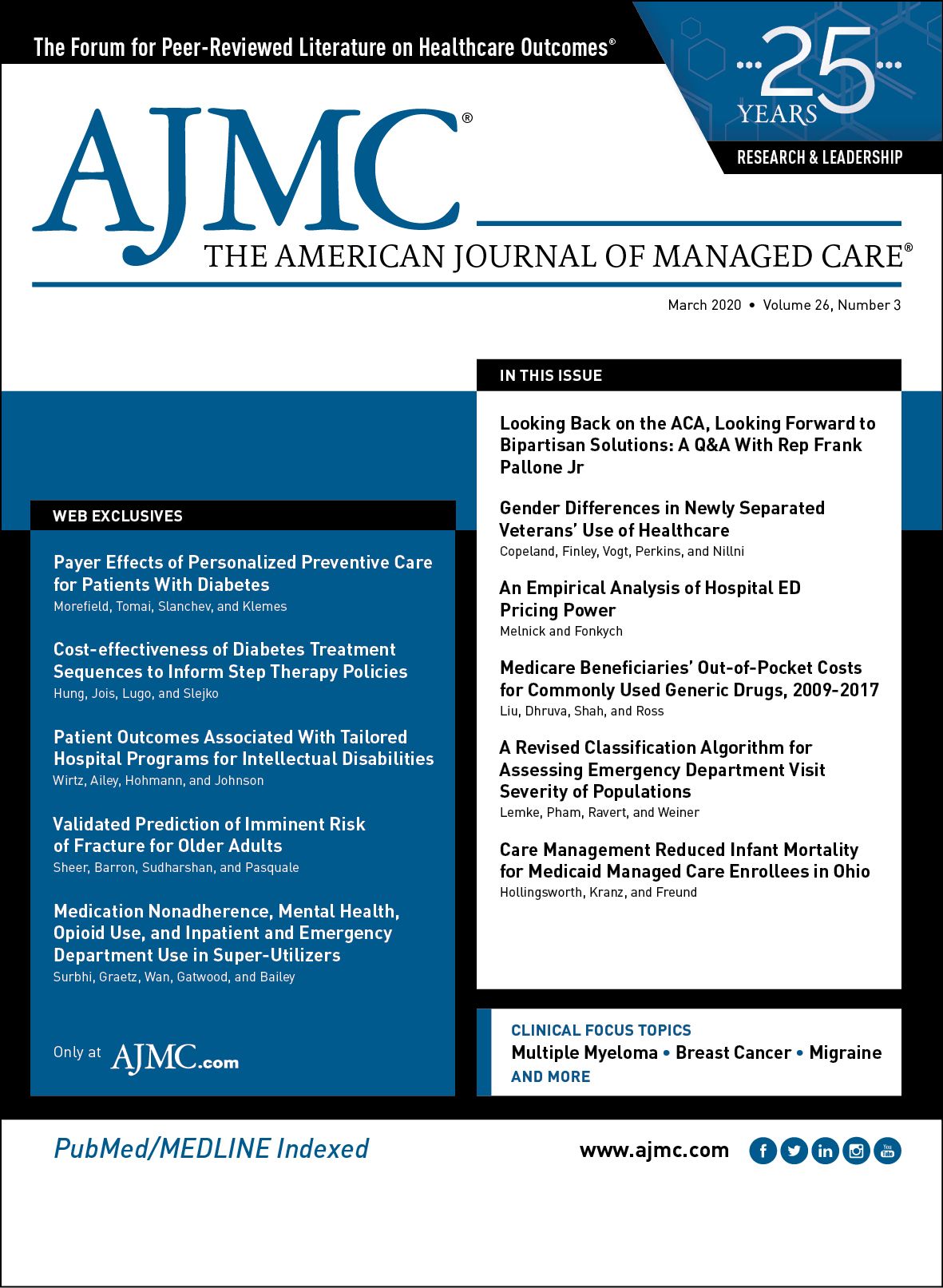- Center on Health Equity & Access
- Clinical
- Health Care Cost
- Health Care Delivery
- Insurance
- Policy
- Technology
- Value-Based Care
The Revolving Door Penalty: Is It a Matter of Time?
The revolving door of readmissions keeps spinning for patients who report symptoms of shortness of breath.
Am J Manag Care. 2020;26(5):197-198. https://doi.org/10.37765/ajmc.2020.43151
Takeaway Points
The revolving door of readmissions keeps spinning for patients who report symptoms of shortness of breath.
- Many variables affect hospital readmissions, such as patients’ comprehension of comorbidities, care fragmentation by multiple clinicians using various electronic health records, and an unforgiving health system that wants more in decreasing clinical time.
- Penalties under the Hospital Readmissions Reduction Program do not address the information technology challenges around fragmentation of care.
- Recognizing the obstacles to clinical care delivery is essential to eliminate low-value care.
The revolving door of readmissions keeps spinning for patients who report symptoms of shortness of breath and cough. Many variables affect hospital readmissions.
The Hospital Readmissions Reduction Program (HRRP) measures 30-day readmissions for 6 diagnoses: pneumonia, chronic obstructive pulmonary disease, heart failure, acute myocardial infarction, coronary artery bypass graft surgery, and elective total hip arthroplasty and/or total knee arthroplasty.1 Shortness of breath is often multifactorial and a common presenting symptom in these frequent diagnoses being monitored under the HRRP.
In the octogenarian patient who is the subject of this commentary, the index hospitalization was at a satellite university hospital, for influenza, pulmonary fibrosis, and recurrent pneumonia. The actual length of stay (LOS) during this index hospitalization was longer than the expected LOS for the diagnosis-related group. A lengthy problem list included significant preexisting chronic burden of illness. At a prompt postdischarge follow-up visit, the covering practitioner was concerned about the patient’s relentless cough and shortness of breath. It was concluded by the practitioner and the patient that the patient was discharged too soon and needed hospitalization again for pneumonia. A direct admission was attempted by the outpatient clinician to their preferred community hospital, but all beds were full, so the patient was sent to the emergency department (ED).
Three days after the index discharge, the patient was at our community hospital for further care, never having been to this second hospital before. ED staff and the patient echoed that the patient was “discharged too soon,” with “persistent cough and shortness of breath.” The patient appeared displeased but not in distress, talking cogently without increased respiratory effort. Vitals were stable on usual home oxygen, and the patient had no fever, chills, or change in sputum. Auscultation revealed loud peristaltic sounds in the chest, along with mild wheeze and Velcro-like crackles. Laboratory results were normal, and x-rays showed patchy air space abnormality in lower lung fields. We reviewed multiple electronic health records (EHRs) and found chest computed tomography scans from 2015, 2017, and 2019 done in different systems (Figure). It was the auscultation of loud peristaltic bowel sounds in the chest that prompted us to look deeper and find imaging studies in multiple records. The hiatal hernia was presumed to be an incidental finding.
The patient did not recall any discussion about how the large hiatal hernia can contribute to reflux, cough, and shortness of breath or aspiration pneumonitis. After expectations and symptoms management, this Medicare beneficiary was discharged following hospital observation, so this was not a readmission. Thereafter, patient had no further hospitalizations for 7 months.
Due to fear and uncertainty, clinicians tend to overdo sometimes, inadvertently leading to a readmission for lack of improvement in symptoms. Pneumonitis can be due to aspiration, hypersensitivity, radiation, or exposure to other chemicals and environmental irritants. The connection among hiatal hernia, gastroesophageal reflux disease, and chronic lung disease is intriguing. Mechanisms involved in pulmonary symptoms include tracheal microaspiration, acid that stimulates bronchospasm, and increased airway hyperreactivity associated with acid reflux into the lower esophagus.2
Readmissions affect patients’ perceptions of care, in addition to their cost of care. In a patient survey, 76.5% of respondents reported that the reason for their readmission was symptoms, frequently being shortness of breath, nausea/vomiting, and abdominal pain. However, some patients did report non—symptom-related reasons for their readmissions; 1.3% reported that they felt they had been discharged too early from their previous hospitalization.3
During an outpatient visit, practitioners have to acknowledge many best practice alerts and scroll through multiple tabs in the vertical and horizontal bars built into EHRs. Deciphering a clinical problem and helping patients understand their illness takes time. It is also time-consuming to reference multiple EHRs, and in each instance, the practitioner needs to make a decision to look (or not) at the multiple sections of EHRs.4 While they are learning the compliance requirements of one system, clinicians are less likely to become truly expert users in multiple systems. Overcoming the current challenges in health information technology, such as interface design and developing navigation efficiency in interconnected systems—thus enabling seamless review of patient data—is essential for care delivery.5
A deeper dive is needed to connect the dots and anchor the revolving door of readmissions. Less fragmentation of care via more informational continuity of care will bring a more satisfying experience for our patients and providers. Author Affiliations: Reliant Medical Group (part of OptumCare), Worcester, MA; St. Vincent Hospital, Worcester, MA; University of Massachusetts Medical School, Worcester, MA.
Source of Funding: None.
Author Disclosures: The author reports no relationship or financial interest with any entity that would pose a conflict of interest with the subject matter of this article.
Authorship Information: Concept and design; acquisition of data; analysis and interpretation of data; drafting of the manuscript; critical revision of the manuscript for important intellectual content; provision of patients or study materials; administrative, technical, or logistic support; and supervision.
Address Correspondence to: Renu S. Goyal, MD, St. Vincent Hospital, 123 Summer St, Ste 521, Worcester, MA 01608. Email: renu.goyal@reliantmedicalgroup.org.REFERENCES
1. Hospital Readmissions Reduction Program (HRRP). CMS website. cms.gov/Medicare/Medicare-Fee-for-Service-Payment/AcuteInpatientPPS/Readmissions-Reduction-Program.html. Accessed October 25, 2019.
2. Wu DN, Tanifuji Y, Kobayashi H, et al. Effects of esophageal acid perfusion on airway hyperresponsiveness in patients with bronchial asthma. Chest. 2000;118(6):1553-1556. doi: 10.1378/chest.118.6.1553.
3. Felix HC, Seaberg B, Bursac Z, Thostenson J, Stewart MK. Why do patients keep coming back? results of a readmitted patient survey. Soc Work Health Care. 2015;54(1):1-15. doi: 10.1080/00981389.2014.966881.
4. Payne T, Fellner J, Dugowson C, Liebovitz D, Fletcher G. Use of more than one electronic medical record system within a single health care organization. Appl Clin Inform. 2012;3(4):462-474. doi: 10.4338/ACI-2012-10-RA-0040.
5. Sittig DF, Wright A, Coiera E, et al. Current challenges in health information technology—related patient safety [published online December 11, 2018]. Health Informatics J. doi: 10.1177/1460458218814893.

Trends in Hospital Pricing for Vulnerable Emergency Department Users, 2021-2023
December 4th 2025Self-pay emergency department prices rose significantly from 2021 to 2023, especially at for-profit and system-affiliated hospitals, highlighting growing affordability challenges for uninsured and underinsured patients.
Read More
Integrated Care for Chronic Conditions: A Randomized Care Management Trial
December 3rd 2025The authors sought to understand the differential impact of payer-led community-based care management approaches on stakeholder-oriented outcomes for publicly insured adults with multiple chronic conditions.
Read More

